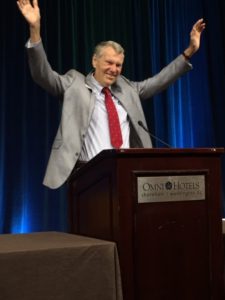Contributing writer: Gloria Tierney

A recent article by Voice of San Diego criticized Coronado City Council’s climate change preparedness.
The article took an indescribably large problem and laid it at the feet of the Mayor and Council members.
By writing a simplistic, inflammatory article, the Voice of San Diego missed a great deal of real information.
The article missed the opportunity to discuss how if one island’s City Council can’t prepare for rising sea levels across the globe due to climate change, no wonder that around the world, island nations are currently petitioning the United Nations for international assistance; and most importantly it missed an opportunity to highlight Coronado’s star climate change resident, Marshall Saunders, and the Citizens’ Climate Lobby (CCL) that he started in the early 2000s.
Significantly, Coronado resident Saunders, and the CCL that he founded, are fundamentally impacting the United States of America’s response to climate change.

This mighty climate change lobby, located at 1330 Orange Ave, has over 19 people on staff (three are Coronado residents), over 1,000 registered members, 25,000 volunteers, and 500 lobby teams. 325 of these lobby teams are in the U.S. with the rest of the lobby teams in Western Europe, Africa, and southeast Asia.

Whatever your thoughts on climate change, there are various predictions of sea-level rise that would impact Coronado Beach, Silver Strand Beach, and the San Diego Bay.
The San Diego County Bi-Partisan Report (San Diego 2050) on Climate Change suggests a rise of between five and 24 inches of water by 2050.
Cliff Maurer, Director of Engineering and Public Services for the City, noted similar statistics from National Oceanic and Atmospheric Administration (NOAA): “In 2030 a six inches’ rise was likely, a 12-inch rise possible; in 2050 11-inch rise possible, 24 inches was possible, by 2100 36 inches was likely, 66 possible.”
So the San Diego report is saying six inches in a little over 30 years and NOAA is predicting six inches in about 14 years.
Who would be most impacted by a six inch rise in sea levels?
The San Diego County report suggests that the Cays underpass and the folks on First Street would be impacted the most.
Brian Holland, Climate Program Manger for the City of San Diego, Local Governments for Sustainability, in “Sea Level Adaptation Strategy for San Diego Bay” notes that the residential neighborhoods most at risk in 2100 in Coronado are the Coronado Cays and First Street.
Maurer noted that some areas of Coronado have always been susceptible to flooding:
“There are a few areas around Coronado that are particularly vulnerable. They are the same areas that flood when it rains: sections of the Country Club, First Street, especially in front of the Ferry Landing, the underpass across from the Cays entrance, the five-point intersection in front of the Tennis Center, Orange, G and F Avenues, between Fifth and Sixth Streets.”
Regarding the Spanish Bight, Maurer noted that: “the area is not below sea-level, but portions of it were filled in after World War II. The sea continues to rise there.”
Maurer noted: “The city has pump and drainage systems to protect these areas. In the Spanish Bight there are seven pumps, two are sewage, two are capable of pumping 46 gallons per minute. Next year the city will install a new pump at Parker Station.”
Past precedent suggests that property owners would be financially responsible for their own property. As an example, a large tree is growing on the median in front of your house. The tree is part of nature. If tree growth starts to do damage to your house, you, not the city, are responsible for protecting your house from the expanding tree.
I wanted to know: Did the Voice of San Diego (VOSD) have a point in criticizing Coronado for not being more prepared?
Maurer suggested that “given these statistics, [we don’t] want to be alarmist. Sea-level rise is certainly a concern, but not an immediate one. There are no sharks circling.”
He continued: “Because the risk is so far into the future the city manager has not gone to city council for an official policy, however the staff does include climate change factors in all capital improvement projects close to the coastline going forward.”
Our Mayor, Casey Tanaka, echoed this point of view.
Mayoral candidate Richard Bailey comes to the same conclusions:
“In regards to the VOSD story, rising sea levels are not as much an immediate threat to our community as they are to other cities along the coast.
As the story mentioned, we have very wide beaches at north and central beach as well as rocks and seawalls which serve as protection whereas other cities do not have this luxury.
We also have the financial resources necessary to make structural modifications if and when necessary in the future as changing conditions may require.”
Mayoral candidate Carrie Downey shared a similar view: “Although the City of Coronado has not adopted a formal ‘Sea-level rise’ Policy, we have been following, and participating when invited, into the studies done by the United States Navy, the Port of San Diego, and several others.
None of the scenarios would have any meaningful effect in Coronado for decades.”
Yet it was this perspective that was criticized in the Voice of San Diego article.

Saunders, who does think we should be alarmed, dismissed any kind of indignation toward the city.
The Voice of San Diego article pointed out ideas that could be considered for Imperial Beach, such as a wall and sandbags.
I asked Saunders: “Do we built a sea wall?”
Saunders thought not: “Do we put a three foot wall around Coronado? No. When you start adapting, what are you adapting too? Things will keep changing.”
But the Voice of San Diego noted the wall idea for Imperial Beach. The article states: “If it’s about protecting beachfront homes, a seawall behind a narrowing beach would do the job.”
The article does acknowledge the costs to aesthetics with such a plan: “But a 40-foot seawall to protect beachfront property from eroding waves cuts against the value of the treasured property – beach access and oceanfront views.”
I will not editorialize on what Coronado residents would think about a 40-foot wall.
The other proposal for Imperial Beach was providing sandbags at the beach.
Coronado City Council provides us with plenty of sand bags, and we are fortunate to have our rock wall along most of Ocean Avenue as well as an expansive sand beach.
How is Coronado prepared?
First of all, we have large capital reserve for any problems we may encounter in the future. Mayor Tanaka, and both mayor candidates, Richard Bailey and Carrie Downey, agreed on this fact.
As far as city property, Downey suggested that “the only new building currently proposed on the beach that could be vulnerable to sea level rise is the South Beach restroom. We have designed the building to withstand possible occasional flooding either caused by 100 year storms or inundation from sea level rise high tides. ”
Mayor Tanaka noted that Coronado has done much in recent years: “Things that we have done in the last 5-10 years include building our own city buildings to LEED Silver standards, adding the HERO program to give our residents another option for financing energy saving home improvements.”
The free shuttle is another example of the city working to reduce carbon emissions and traffic.
Blair King, Coronado City Manager noted that: “We probably have the highest number of low speed electric vehicles per capita in San Diego County. We provide for bicyclists and pedestrians. We are preparing an alternative transportation masterplan. Based upon miles driven, I suspect our carbon footprint is already relatively small. ”
So if we have the wide beach, a rock wall on Ocean, plenty of sandbags, and the capital reserves for any big, unforeseen project, why is Saunders so passionate?
It’s a national security issue.
There are many complex reasons for ISIS et al., but one reason that has been articulated in fine print by the U.S. Navy no less, is that climate change and the associated rise in temperatures and desiccated lands is one of the greatest threats to U.S. security.
“The U.S. military has characterized climate change as a threat to national security since at least 2014, saying drought and other natural disasters can foster instability, conflict and extremism.” ( | 8:47 a.m. April 12/15, 2016 – As reported in the San Diego Union Tribune.)
Maybe it’s time to listen to what the U.S. Navy and others have to say about global warming. Even if you don’t believe global warming is man-made, we still must address the consequences, no matter what is causing it.
Coronado may be fine, but there are larger issues at stake.
Naomi Klein in her book This Changes Everything, suggests that we need a “Marshall Plan” for the Earth. During WWII, the ‘Greatest Generation’ made real sacrifices to protect U.S. citizens, perhaps it’s time for us to think the same way about climate change – that we will have to work together as a nation to make a real impact.
Continue on to Part 2 of this article to learn about actionable steps we can take to reduce global warming.
By Ann Marie Bryan and Gloria Tierney
Article was updated on June 4, 2020 to correctly reflect the San Diego County Bi-Partisan Report (San Diego 2050) on Climate Change suggestion of a rise “of between five and 24 inches” of water by 2050.




